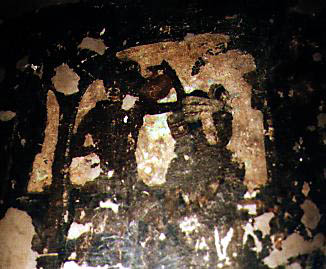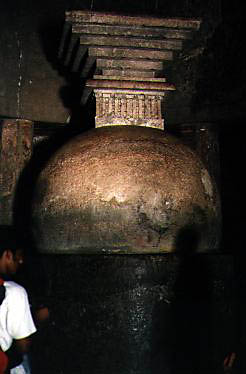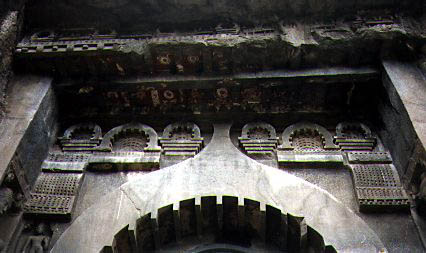
CAVE 9 AJANTA


On April 28, 1819, John Smith of the 28th Madras Calvary
scratched his name into a wall of Cave 9. He had rediscovered the caves
of Ajanta, and his discovery opened the debates of date and origins which
still rage today.
The graffiti of John Smith is out of easy reach today.
When he came upon the caves, they had been half-filled with silt and rubble.
However, other tourists also came, and also scrawled their name upon the
paintings of Caves 9 and 10. This is particularly unfortunately, bacuse
these paintings are among the earliest extant in India; and they are presently
almost invisible from weathering and damage.

Wall painting of Cave 9, in a royal procession
scene. These early paintings may date as early as the first century BC.
Cave 9 is part of the heart of the Ajanta complex, begun
in the second or first centuries BC. It is a large liturgical hall, with
a monolithic stone stupa carved from the living rock.

Stone stupa of Cave 9.
The cave was restored and refurbished in teh fifth century,
when the site experienced a renaissance. painting on the porch and interior
pillars date from the fifth century.

The facade of Cave 9, the caitya arch and painted
lotuses in the carved rafters.

Buddha painting on the pillars of Cave 9.
The fifth century paintings are flatter, with severe color
modeling and more angular poses than the earlier murals.
There have been some attempts of cleaning and restoring
the paintings of caves 9 and 10, which can be seen especially in the mouldings
above the pillars.
There are also several small shrines
carved between caves 9 and 10.


 Have pictures
of Cave 9 you would like to share? Please contact me!
Have pictures
of Cave 9 you would like to share? Please contact me!
 Return to the Ajanta
Site page.
Return to the Ajanta
Site page.
![]()






